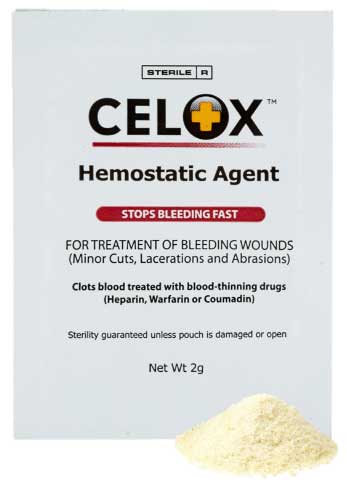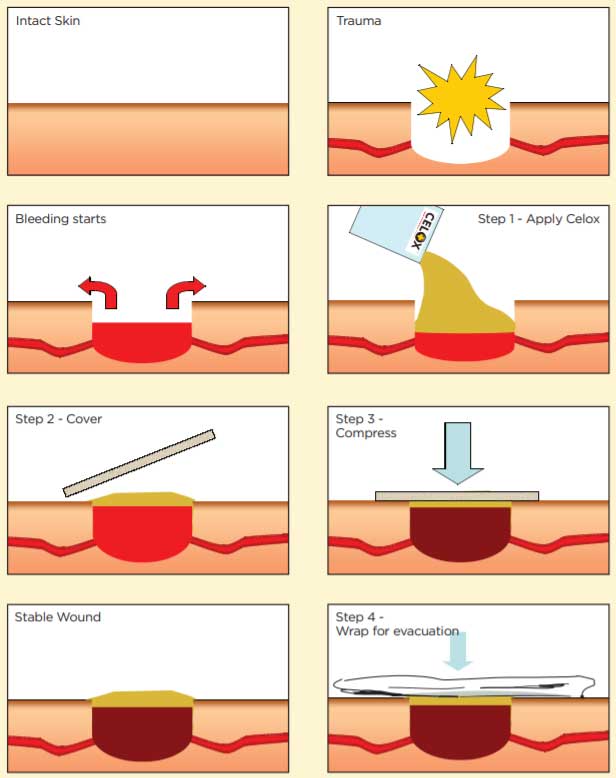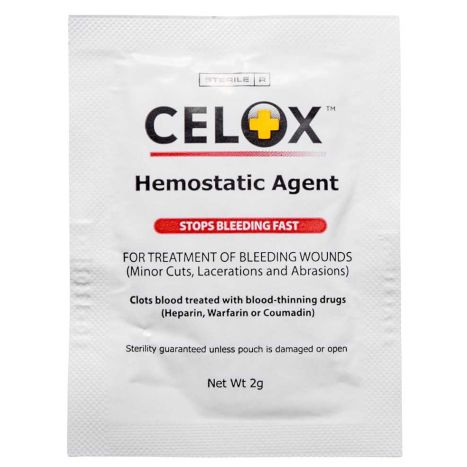Blood Clotting Agent Overview
Celox hemostatic granules stops severe bleeding fast. Manufactured by MedTrade with chitosan, Celox Topical Hemostatic Granules provides for the external and temporary control of severely bleeding wounds to achieve hemostasis and prevent blood loss. Its design is for emergency use. Celox offers a safe and easy-to-use agent for the local management of bleeding, such as lacerations, minor cuts, and abrasions. It molds to the shape of the wound on the source of the bleeding, even onto complex-shaped injuries. This product is not mineral-based, and residual chitosan material breaks down in the body without impairing any functions.
Celox gels, swells, and sticks together to form a clot without interference to the natural clotting cascade. It cannot enter the bloodstream or hinder normal functions. When the granules come into contact with blood, they absorb fluid, swell, become a gel and stick together to create an artificial clot. It is so versatile that it even works for your pets. A pet with cut pads or paws, or even if their nails are clipped too short, the homostatic granules will stop the bleeding.

Celox Blood Clotting Granules has been proven to work on moderate to severe bleeding and tested extensively in combat emergencies. In an independent trial by the US Navy, when compared to Quikclot* and gauze, Celox was the only product to offer 100% survival. It was also a superior product to provide clotting with no rebleeding.1
Celox Granules Advantages
- Reliably stop arterial bleeding
- Clots hypothermic blood
- Clots blood containing Warfarin or Heparin
- Battlefield proved
- Easy-to-use
- Fast working
- Lightweight and compact
- Pocket size
- Stops nosebleeds
- Forms a cross-linked barrier clot
- Easily self-administered
- Does not sting or burn
- Easily washes away with saline or water
- Save lives

Despite advances in medical intervention and protective equipment, fatal traumatic hemorrhage remains one of the most challenging problems for both military and civilian medicine. Uncontrolled hemorrhage currently accounts for almost 50% of battlefield deaths before evacuation in Iraq and Afghanistan. Additionally, civilian trauma death from exsanguination approaches 80% in the United States, accounting for the second leading cause of trauma death overall.
Additionally, like other chitosan?based products, Celox hemostatic granules are easily removed. When activated, it forms a soft, mildly sticky, gel?like mass that removes with manual extraction. Residual material easily washes from the wound with simple saline lavage. However, we believe one of the most significant benefits of this agent is employing it in a granular form. A non-exothermic dressing that can conform to wound contours is highly desirable in certain situations.2
In another military study, the use of Celox as a hemostatic agent to control excessive bleeding from a traumatic wound in southwestern Afghanistan found that it is effective and a useful adjunct for treating massive bleeding. It treated 21 gunshot wounded soldiers with success in 18 soldiers with the first application. The other three soldiers also had success in bleeding cessation after three applications.3
According to the Annals of Thoracic Surgery, the product is "for moderate to severe hemorrhage and currently used for hemostasis in the emergency and military settings."4 The Ulus Travma Acil Cerrahi Derg indicates that the granular formula "provides effective hemorrhage control under conditions of normothermia, hypothermia, and use of the oral anticoagulant agent warfarin."5
Product Features & Benefits
- Works with Cold and Thinned Blood
- Quickly Creates a "Pseudo-Clot"
- Topical Application
- Dermal Sensitization
- Bio-Absorbable
- Bio-Compatible
- Easily Packed, Carried, and Applied
- Application By One Hand If Needed
- Suited for Moderate Wounds
- Compatible with Large Eviscerating Wounds
- Creates Hemoloysis by Coagulation
- Clots Blood Fast, Within 30-Seconds
- Clots Blood Containing Heparin or Warfarin
- Does Not Generate Heat
- Not Flammable
- Over-the-Counter Availability
- Usable on Humans and Pets
- Molds to the Shape of the Wound
- Offers Highest Survival Rate in Comparison with Competitor Products
- Reduces the Risk of Spreading Blood-Borne Pathogens
Product Specifications
- Product Number: 0711GNS
- Volume: 2 Grams
- Material: Cellulostic Polymer - Polynactylglucosamine
- Active Ingredient: Chitosan
- Color: White
- Application: Hemostatic Agent
- Sterilized: Gamma Irradiation
- Packaged: Pocket Size Foil Sachet
- Shelf Life: 4-Years
- Non-Allergenic
- Generally Recognized As Safe Food Ingredient
- FDA Compliance: 21 CFR s 170.30
- Prescription Requirement: None
- Manufacturer: MedTrade

Indications
- Arterial and venous bleeding
- Moderate to severe bleeding
- Complex and deep wounds
Contraindications and Cautions
- Do not apply over eyes
- Do not use inside the mouth
- Not intended for internal surgical use
Product Use Instructions
- Identify catastrophic external hemorrhage.
- Expose the wound.
- Identify the point of bleeding and apply direct pressure.
- Swab excess blood.
- Pour onto the source of bleeding.
- Cover and apply firm pressure for 5-minutes, or until bleeding stops.
- Secure with a dressing to maintain pressure and discard what is not used.
- Tuck Celox packaging into the bandage.
- Transfer the casualty to the next stage of care.
Step-by-Step Instructions

Each year thousands of trauma victims die of hemorrhage from car accidents, assault, workplace accidents, and domestic mishaps. Trauma accounts for 41 million emergency room visits annually. It is the leading cause of American deaths between the ages of 1 and 46 years old. That is more than 192,000 people in the US that lose their lives due to trauma each year.
Product Applications
Celox has numerous applications wherever and whenever bleeding needs curtailing. Someone can bleed to death in as little as 5-minutes. Stopping the loss of blood is critical. Below is a list of where this product is commonly in use.
Hospitals
Celox stops bleeding in surgery and emergency rooms. It is a chitosan product that is a natural polysaccharide. It works independently of the body's normal clotting functions. Polysaccharide quickly clots blood to stop the bleeding.

Emergency Medical Services
Medical emergencies involving bleeding victims need an effective hemostatic to save lives. Emergency Medical Technicians (EMT) often find accident victims in shock, hypothermic, or developing coagulopathies. Each of these events can prevent attempts to stop bleeding. Celox works with hypothermic blood and blood-thinning agents like Heparin and Warfarin that may prevent coagulation with other therapies. Paramedics, EMT's, and Fire service-based EMS use Celox to control arterial bleeding at the scene.
Law Enforcement
The police are often the first responders on the scene. Often they need to act fast and make use of the best at their disposal to stop severe bleeding and save lives. The use of Celox in emergencies helps stabilize catastrophic injuries to allow medical personal to intervene when they arrive.
Military
Celox is used on the battlefield by stopping catastrophic bleeding. It is lightweight to carry into battle and easy to administer. Fast-acting and effective, Celox stops bleed to save lives.
Remote Emergency Care
People who live, work, or play hours away from any hospital care or emergency care are at risk. Accidents and injuries can happen anywhere. Merchant shipping, forestry service, oil exploration, pipe laying, wilderness expeditions, and a host of other activities may keep people removed from emergency care that can respond to an accident. Under remote conditions, preparation and self-reliance can save lives until professional medical care is available. Celox can buy time for an injured person to get them back to civilization for medical attention.
First Aid Kits
This medical product gels and swells up in contact with a bleeding wound. It sticks together to form external clotting. The product does not produce heat and works independently of the body's other functions. It is lightweight and compact for simple adding to any first aid kit. Be prepared at work, home, traveling, and wherever accidents might happen.
Consumers
People can bleed to death in just 5-minutes. Stopping the bleeding quicky in a traumatic incidence is critical. Whether faced with violence, auto accidents, terrorism, or a mass casualty event, anyone can be prepared to respond appropriately to save lives. Coagulopathic casualties may be cold, hypothermic, or using anticoagulant drugs like Warfarin or Heparin. Celox is effective despite the typical conditions that an accident victim may incur.

Manuals and Documents
-
 Flyer contains product features and benefits.
Flyer contains product features and benefits. -
 Product Guide contains product information.
Product Guide contains product information. -
 Instructions for Use contains how to use information.
Instructions for Use contains how to use information. -
 Hemostatic offers information about this blood clotting formulation.
Hemostatic offers information about this blood clotting formulation. -
 FDA Letter specifies product indications.
FDA Letter specifies product indications. -
 MSDS offers statement on material safety.
MSDS offers statement on material safety.
Footnotes
- 1 Kozen, Buddy G., et al. "An alternative hemostatic dressing: comparison of CELOX, HemCon, and QuikClot." Academic Emergency Medicine 15.1 (2008): Page 77. (Last Accessed September-23-2020)
- 2 Kozen, Pages 75 and 79. (Last Accessed September-23-2020)
- 3 Pozza, Moreno, and Russell WJ Millner. "Celox (chitosan) for haemostasis in massive traumatic bleeding: experience in Afghanistan." European Journal of Emergency Medicine 18.1 (2011): 31-33. (Last Accessed September-23-2020)
- 4 Millner, Russell WJ, et al. "A new hemostatic agent: initial life-saving experience with Celox (chitosan) in cardiothoracic surgery." The Annals of thoracic surgery 87.2 (2009): e13-e14. (Last Accessed September-23-2020)
- 5 Koksal, Ozlem, et al. "Hemostatic effect of a chitosan linear polymer (Celox®) in a severe femoral artery bleeding rat model under hypothermia or warfarin therapy." Ulus Travma Acil Cerrahi Derg 17.3 (2011): 199-204. (Last Accessed September-23-2020)
Medical Studies
-
 Bennett, Brad L., and Lanny Littlejohn. "Review of new topical hemostatic dressings for combat casualty care." Military medicine 179.5 (2014): 497-514. (Last Accessed September-23-2020)
Bennett, Brad L., and Lanny Littlejohn. "Review of new topical hemostatic dressings for combat casualty care." Military medicine 179.5 (2014): 497-514. (Last Accessed September-23-2020) -
 Clay, Jared G., J. Kevin Grayson, and Dustin Zierold. "Comparative testing of new hemostatic agents in a swine model of extremity arterial and venous hemorrhage." Military medicine 175.4 (2010): 280-284. (Last Accessed September-23-2020)
Clay, Jared G., J. Kevin Grayson, and Dustin Zierold. "Comparative testing of new hemostatic agents in a swine model of extremity arterial and venous hemorrhage." Military medicine 175.4 (2010): 280-284. (Last Accessed September-23-2020) -
 Crunkhorn, R., R. Burnham, and G. Walton. "Successful use of a military-grade haemostatic agent for a major head and neck bleed." The Journal of Laryngology and Otology 127.10 (2013): 1031. (Last Accessed September-23-2020)
Crunkhorn, R., R. Burnham, and G. Walton. "Successful use of a military-grade haemostatic agent for a major head and neck bleed." The Journal of Laryngology and Otology 127.10 (2013): 1031. (Last Accessed September-23-2020) -
 Devlin, John J., et al. "Comparison of ChitoFlex®, CELOX™, and QuikClot® in control of hemorrhage." The Journal of emergency medicine 41.3 (2011): 237-245. (Last Accessed September-23-2020)
Devlin, John J., et al. "Comparison of ChitoFlex®, CELOX™, and QuikClot® in control of hemorrhage." The Journal of emergency medicine 41.3 (2011): 237-245. (Last Accessed September-23-2020) -
 Gegel, Brian, et al. "The effects of BleedArrest, Celox, and TraumaDex on hemorrhage control in a porcine model." Journal of Surgical Research 164.1 (2010): e125-e129. (Last Accessed September-24-2020)
Gegel, Brian, et al. "The effects of BleedArrest, Celox, and TraumaDex on hemorrhage control in a porcine model." Journal of Surgical Research 164.1 (2010): e125-e129. (Last Accessed September-24-2020) -
 Kheirabadi, Bijan S., et al. "Comparison of new hemostatic granules/powders with currently deployed hemostatic products in a lethal model of extremity arterial hemorrhage in swine." Journal of Trauma and Acute Care Surgery 66.2 (2009): 316-328. (Last Accessed September-23-2020)
Kheirabadi, Bijan S., et al. "Comparison of new hemostatic granules/powders with currently deployed hemostatic products in a lethal model of extremity arterial hemorrhage in swine." Journal of Trauma and Acute Care Surgery 66.2 (2009): 316-328. (Last Accessed September-23-2020) -
 Littlejohn, Lanny, Brad L. Bennett, and Brendon Drew. "Application of current hemorrhage control techniques for backcountry care: part two, hemostatic dressings and other adjuncts." Wilderness & environmental medicine 26.2 (2015): 246-254. (Last Accessed September-23-2020)
Littlejohn, Lanny, Brad L. Bennett, and Brendon Drew. "Application of current hemorrhage control techniques for backcountry care: part two, hemostatic dressings and other adjuncts." Wilderness & environmental medicine 26.2 (2015): 246-254. (Last Accessed September-23-2020) -
 Smith, Adam Hewitt, et al. "Haemostatic dressings in prehospital care." Emergency Medicine Journal 30.10 (2013): 784-789 (Last Accessed September-23-2020)
Smith, Adam Hewitt, et al. "Haemostatic dressings in prehospital care." Emergency Medicine Journal 30.10 (2013): 784-789 (Last Accessed September-23-2020)
Product Videos
Introducing Celox First Aid Video (3:37 minutes)
Clotting Demonstration Video (2:02 minutes)
Celox Comparison Test Video (2:57 minutes)
Celox Military Training Video (5:07 minutes)



Login and Registration Form